|
|
|
 |
Faerie Page |  |
|
Faeries This page is just for the love of the Fea. Here I have information on faeries of all kinds. So listen, learn and enjoy the faeries. |
|
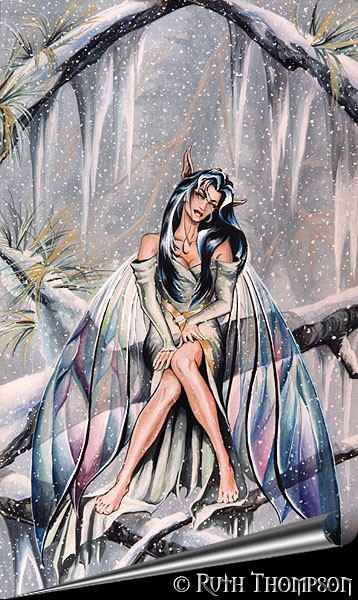 |
Other names of the fae.. Fays - early form of the word Fair Family/Fair Folk - Welsh nickname Farisees/Pharisees - Suffolk nickname Fary - Northumberland nickname Fees - Upper Brittany nickname Feriers/Ferishers - another Suffolk nickname Frairies - Norfolk and Suffolk version Good Neighbors - Scottish and Irish nickname Good People - Irish reference to the Sidhe The Green Children - Faerie reference in medieval literature Greencoaties - Lincolnshire Fen version Greenies - Lancashire nickname The Grey Neighbors - Shetland nickname for the Trows Henkies - Orkney and Shetland nickname for Trows Klippe - Forfarshire nickname Li'l Fellas - Manx nickname The Old People - Cornish nickname People of Peace - Irish reference to the Sidhe Pigsies/Piskies - Cornwall variations of Pixies Sith/Si - Gaelic variations of Sidhe Sleigh Beggey - Manx language version of Little Folk The Small People of Cornwall - Cornwall variation Still-Folk - Scottish Highland version Themselves/They/Them that's in it - Manx replacements for "Faerie" Verry Volk - Gower (Wales) nickname Wee Folk - Scottish and Irish nickname |
| Plants ans Trees. Foxglove Name is derived from "Little Folks' Glove". Florets are worn by Faeries as hats and gloves. Primroses Make the invisible visible. Eating them lets you see Faeries. If one touches a Faerie rock with the correct number of primroses in a posy, the way to faerieland and Faerie gifts is made clear. The wrong number means certain doom. Ragwort Used as makeshift horses by the Faerie. Wild Thyme Part of a recipe for a brew to make one see the Faeries. The tops of the Wild Thyme must be gathered near the side of a Faerie hill. Cowslips These are loved and protected by the Faeries. They help one to find hidden Faerie gold. Pansies the flower that was used as a love potion by Oberon, a Faerie king thought to have been invented by Shakespeare. Bluebell One who hears a bluebell ring will soon die. A field of bluebells is especially dangerous, as it is intricately interwoven with Faerie enchantments. Clover A four-leafed one may be used to break a Faerie spell. St. John's Wort Has a calming effect, used when stress is overwhelming. Helps break spells as well. Hazel Celtic legend says it is the receptacle of knowledge; the hazelnut is a symbol of fertility in England. White Oak Bark Cleanses and tones entire alimentary canal (tract that food passes through from ingestion to elimination), excellent astringent. Good for external and internal hemorrhage - bleeding in stomach, lungs, rectum. Rowan Protects against bad spirits. Used in butter churns so that the butter would not be overlooked by Faeries. Bewitched horses may be controlled by a rowan whip. Druids used rowan wood for fires with which they called up spirits whom could be forced to answer questions when rowanberries were spread over the flayed hides of bulls. Buckthorn Made from bark, aids liver congestion, helps to carry blood and liver toxins out of the body. Good for gall stones, lead poisoning. Oak Oakmen are created when a felled oak stump sends up shoots. One should never take food offered by them since it is poisonous. Willow At night they uproot themselves and stalk travelers, muttering at them. Elder Sometimes is a witch disguised as a tree. Never lay a baby in an elderwood cradle or the Faeries will pinch them so they bruise. Burning elder wood is dangerous since it invites the Devil. Birch If the spirit of the birch tree (The One With the White Hand) touches a head it leaves a white mark and the person turns insane. If it touches a heart, the person will die. Alder Protected by water spirits. Apple To ensure good harvests, leave the last apple of your crop for the Apple-Tree-Man. Ash Druids wands were made of ash twigs. It also has healing properties. Weak-limbed children were passed through split ash trees which were then bound up. If the tree grew straight, the child would as well. Also may be used as a substitute for Rowan. Toadstools Some have poisonous hallucinogenic properties. The Vikings ate it and gain their reputations as berkerkers. In Celtic lore, they are among the food of the gods, as with many red plants. Some toadstools associated with the Faerie are Fly Agaric, Yellow Fairy Club, Slender Elf Cap, Dune Pixie-Hood, and Dryad's Saddle. Fairy Ring Mushroom Marks the boundaries of Faerie rings. |
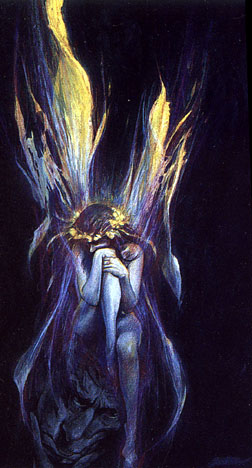 |
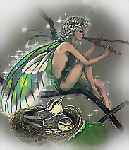 |
Faerie Land The Faerie are from the Celtic-myths, nature spirits brought to life by the essence that they represent. Pembrokshire Coast the Welsh thought it to be an invisible island in the Irish Channel just off this coast Laugharne and Milford Haven the Faerie are reported to frequent these markets Hy Breasail elusive island to the west of Ireland where they lived Isle of Man British version of the island theory Hollow Hills ancient forts, barrows, and earthworks. May raise itself up on pillars at night during Lammas Tide (August 7). King Arthur may have been buried in one. Silbury Hill, Wiltshire King Sil in his golden armor was buried here atop his horse Bryn y Ellyllon translates to Hill of the Goblins, near Mold, Clyd Flint Castle Neroche in Somerset. Faeries defended their hill from gold seekers by instilling the miners with a fierce panic and they all died within a month of the attempt. Orkney a Trow warned a farmer there not to dig in a certain mound. The warning was ignored and the farmer lost his cattle and family. Faerie Rings Faeries dance in circles and their music lures humans to them. Once inside, a human cannot escape unless a human chain from the outside is formed to pull him/her out. Inside, what seems like a couple minutes could actually be several days. Gump Hill near Cornwall, reported to be a popular Faerie meeting place Faerie Islands elusive islands where all is happiness, it is always Spring, and no one ages or falls ill. Some float, some are underwater and only come up at night, some are only visible every so often. Among the best known are the Isles of the Blest (a/k/a Fortunate Islands), Tir Nan Og (the Land of the Young), Tirfo Thuinn (the Land Under the Waves), Tire Nam Beo (Land of the Living), Tirn Aill (the Other World), Mag Mor (the Great Plain), Mag Mell (the Pleasant Plain), and Tir Tairngire (the Plain of Happiness). Chaw Gully, Dartmoor The Knockers here are very protective of their mine. Anyone trespassing will be killed when a Knocker cuts the rope and the trespasser falls down the mining shaft. The body is always found the next day neatly laid out at the entrance. Parish of Bodfari, Denbighshire A group of Coblynau were once seen dancing in a field there, dressed as British soldiers with handkerchiefs (red with yellow spots) on their heads. Fincastle Mill It was so haunted no one ever set foot there after dark. One girl who dared to had to defend herself from a leering Brownie who years later killed her by throwing a stool at her. Knockma Hill Under Knockma Hill is King Firvarra's palace. He still holds court there as the leader of the leader of the Daoine Sidhe. |
|
Faerie Calls, Chants, Do's and Dont's Information found... "Lady Cottington's Pressed Fairy Book" If the fae ones wish to remain hidden from view, there is little human kind can do. Remember, when seeking the fae and all nature spirits, you should never wear iron. They despise it! And never whistle in the woods. It disrupts the natural aura of the place. Probably the most well known place to find the Fee Ones is within a natural mushroom ring at sunset or full moonlight. Caution should be taken not to be caught unawares by the fae, especially during the full moon. That way lays madness. It is said that a person can simply look through a stone with an opening, or a hole. This can be a natural hole or a self-bored stone. Naturally holely stones can be found near running water or by the sea. |
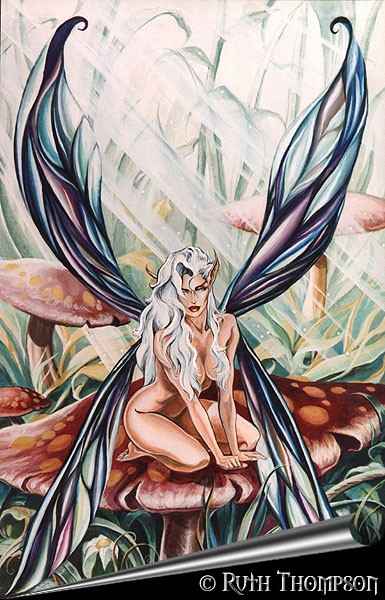 |
|
|
Chant Come out of your Fairy bower Come upon this golden hour Come to us we beg you please Fairys dancing upon the breeze |
|
The Faerie Call A spell for summoning fairies Sit where the cat sits. Cross your toes. Close your eyes. And smell a rose. Then say under your breath: "I believe in fairies, sure as death." Gadflykins! Gladtrypins! Gutterpuss and Cass! Come to me fairily Each lad and lass!. |
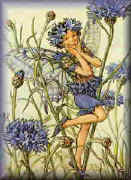 |
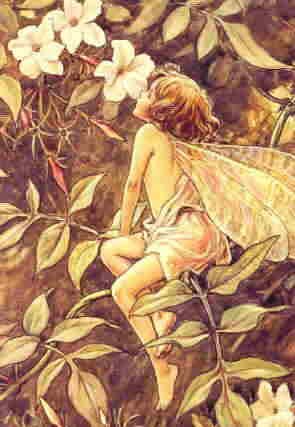 |
And alittle bit more. Many trees are sacred by these wee Ones. The elder tree is said to offer protection from the evil night spirits, and it is said to work for mortals as well. Look in an oak grove. It is said, "Faerie Folks are in old oaks". It wasn't for naught that the druids set such store by oaks. They contain faerie magic! The fruit of the oak tree, acorns, can be made into faerie talismans if found and gathered by the light of the full moon. The adler is also connected to the Faerie, as Robert Graves states in "The White Goddess": "The Adler was, and is, celebrated for yielding fine dyes: green from the flowers and brown from the twigs and red from the berries: typifying fire, water and earth. One reason for the adler's sanctity is that when it is felled the wood, at first white, seems to bleed crimson as though it were a man. (or dryad or Faerie tree spirit!) The green dye is associated in British folklore with the fairies' clothes; so in so far as the fairies may be regarded as survivals of early tribes, forced to take to the hills and woods, the green of the clothes is explained as protective coloring; foresters and outlaws also adopted it in mediaval times. Its use seems to be very ancient." Roses Roses seem to attract the wee ones in a powerful way. If you wear rose oil when seeking the Fae Folk, they will be drawn to you despite their wish. A rose water preparation can be made to bathe in before doing any rite of the Faery Tradition (Wicca). It is traditionally made by taking 21 measures of rose petals and steeping them in a copper kettle with a lid. They should be left to soak for the space of full moon to full moon. This rose water can be used to scent the body and hair and as "holy water" in works of Faerie Magic. Stones & Metals As stated ealier, the wee ones despise iron and, in fact, it is said that particular metal can harm or even kill the fae. If you decide to try your hand at any type of faerie magic, make certain that all of your tools are made of copper, silver or woods that are sacred to faerie. Oak is probably the best to use. If gem stones are to be used, the most appropriate are faerie stones (staurorite), quartz crystal, rose quartz, moonstone, celestite (blue quartz), selenite, amethyst, labradorite, and amber. To guard against mischievious spirits, it is best to use flint. |